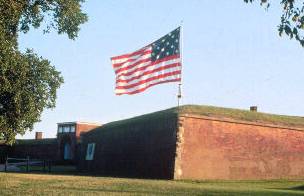Military: War of 1812

Fort McHenry National Monument and Historic Shrine
This late 18th century star-shaped fort is world famous as the birthplace of the American national anthem. The guardian of Baltimore's harbor, it was the valiant defense of Fort McHenry by American forces during a British attack on September 13-14, 1814, that inspired 35 year old, poet-lawyer, Francis Scott Key to write "The Star-Spangled Banner."
Following the Battle of Baltimore during the War of 1812, the fort never again came under attack. However, it remained an active military post off and on for the next 100 years.
During the Civil War, it was occupied by Union forces who used it as a prison camp for the detention of Confederate soldiers, southern sympathizers, and political prisoners.
From 1917 until 1923, U.S. Army General Hospital No. 2 was located here to serve World War I troops. A portion of the 43 acre park was used as a U.S. Coast Guard training facility as late as World War II. It became an area administered by the National Park Service in 1933, two years after Key's poem became this country's national anthem. Of all the areas in the National Park System, Fort McHenry is the only one designated a national monument and historic shrine.
- Fort McHenry National Monument and Historic Shrine
- Horseshoe Bend National Military Park
- Jean Lafitte National Historical Park and Preserve
- Perry's
Victory and International Peace Memorial
Related Links: - Fort McHenry National Monument and Historic Shrine - Historical Handbook Series
- The Battle of Horseshoe Bend: Collision of Cultures
- Teaching With Historic Places: Military History Lesson Plans
Additional War of 1812 Sites:
- Adams, John Quincy, Birthplace
- Boston Naval Shipyard
- British Fort
- Constitution
- Clay, Henry, Home (Ashland)
- Decatur House
- Fort Astoria Site
- Fort Hill (John C. Calhoun House)
- Fort Meigs
- Fort St. Philip
- Grouseland (William Henry Harrison House)
- Hermitage, The
- Monroe, James, Law Office
- Mackinac Island
- Oak Hill
- Octagon House
- Old Hartford Statehouse
- Plattsburgh Bay
- Ross, John, House
- Scott, General Winfield, House
- Springfield Armory
- Star Spangled Banner Flag House
- Tippecanoe Battlefield
- Vieux Carre Historic District
- Washington Navy Yard
- Webster, Daniel, Family Home
- Webster, Daniel, Law Office